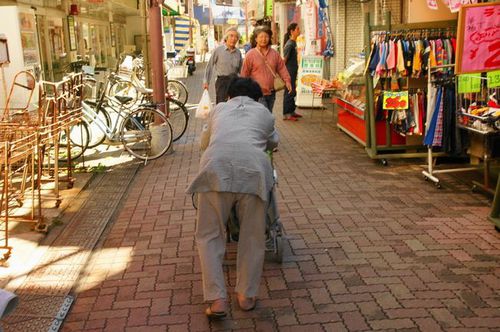January 14, 2015
Toward a Sustainable Japan: Challenges and Changes in Society and Population
Keywords: Newsletter Steady-State Economy
JFS Newsletter No.148 (December 2014)

Image by Hakkenden Some Rights Reserved.
Junko Edahiro, chief executive of Japan for Sustainability, delivered a keynote speech on September 10, 2014, at an international symposium in Austria entitled "Cope with the Stress of Future Changes - Preparing States, Regions, Cities, Organization, Families and People for the Ongoing Transition." It was organized by the Club of Vienna, an international network of experts in economics, plus social, natural and environmental sciences. This JFS Newsletter article is adapted from part of her speech, relating to about local economy in Japan, plus values and lifestyles toward a more sustainable world.
See also:
Toward a Sustainable Japan: Fukushima Accidents Show Japan's Challenges
---------------------------------------
On the climate change front, we have been seeing an increase in extreme rainfall events in Japan. Because of this, the average annual frequency of mudslides due to heavy rain and flooding has increased, and the Japanese government has projected a 4.4 times increase in the likelihood of river flooding at the end of this century. And we have already seen an increased death toll from heat stroke. In 2010, over 1,700 people died from heat stroke in just one year. We can expect an increase in these numbers if we cannot check climate change. We are also seeing negative effects of a warmer climate on agriculture, particularly on rice and fruit growing.
This is all at the same time as we have to cope with the stresses of population decline and the aging of society. One hundred years ago, Japan's population was about 40 million people. It took 100 years to rise to 120 million, and within 100 years, we are likely to be back to 40 million.
And along with aging, demographics are changing. We are heading toward a time when 40 percent of the population will be over 65. Today one in four are over 65 years old. By 2035, it will be one in three. By 2060, two in five will be over 65.
Today we have 2.57 workers supporting each senior citizen. But in 2060, the ratio will be just 1.19 workers per senior. This will put a huge burden on the younger generation. Compare the aging ratios of different countries. Italy, Sweden, Spain, Germany, France, the UK, the United States, and many developing nations are heading toward populations with 25 or 30 percent being over 65. But Japan is far ahead of the world.
And now people are talking about how to keep the pension system alive, because it is projected that if we cannot grow our economy, pension payments for the elderly will have to be reduced by 20 or 40 percent. This all gives the government and economists an excuse to try and grow our economy. But because of population decline, more than 60 percent of Japanese land will be unpopulated by 2050. So national land security is another issue.
Half of the municipalities in Japan are now seen as "municipalities at the risk of vanishing." How is that defined? Municipalities whose population of women aged 20 to 39 are expected to decrease to less than half of current level in 30 years. We are usually talking about birth rates when we talk about population. The number of women of childbearing years has declined, resulting in a decline in the number of births.
Recently a report was released showing that close to 900 municipalities, almost a half of Japan's total, are at risk of vanishing. One village is projected to have only eight women in this age group by 2040. This has resulted in a big fuss in Japan. Mayors and citizens in towns regarded as municipalities at the risk of vanishing are busy of organizing committees or creating special research teams to deal with the issue.
And of course, if you have population decline, you will have workforce decline. Now the government is trying to raise the age used to define the workforce. Japan currently considers the workforce to be aged between 20 and 65, but the government is trying to raise the bar, so you will have to work until the age of 74.
If you take this newly defined working population in Japan, we now have about 90 million workers, by 2060, 52 million, then by 2100, 26 million. This is a huge drop in the workforce. How can we maintain our economy? How can we fulfill the "promise" of economic growth?
All considered, I think the biggest pressure in Japan comes from the obsession for growth on the part of economists, industry, and the government, in spite of the expected population decrease. Companies are busy cutting labor costs in order to maintain profits and contribute to economic growth. So now we have many unemployed people, or low-wage contract workers.
In the past, Japan was well known for its lifetime work system. Job security resulted in a high level of loyalty to one's company. But this is no more the case. Currently one in three workers in Japan is a contract worker. They don't have job security, company pensions, health coverage, and benefits like that.
Meanwhile our wage index is declining sharply, while we also have a rising unemployment ratio and poverty ratio. Another problem is child poverty. The government is not addressing this issue properly yet. One in six Japanese children today is regarded as a child in poverty. This will create a huge problem, not only today but in the future as well.
We have a growing gap between the haves and have-nots. And we have a huge number of suicides. I think we are among the top-ranking countries in the world in terms the number of suicides. Statistics show a huge increase in 1998 to 1999, when economic conditions were particularly bad and created serious unemployment. Before that, we had a kind of social safety net, not by the government but by companies. But companies have to compete against the global market, so they were trying to reduce that kind of social network or social safety net. People got fired, without any support from the government or the company. One of the characteristics of this huge increase in suicides in Japan is the prominence of men in their forties and fifties. The suicide ratio in that age bracket has grown dramatically.
An opinion poll of the percentage of people who said "I'm satisfied with myself" showed that compared to other countries surveyed, Japan had fewer people satisfied with themselves. With the percentage of the people who said "I have bright hope for the future" as well, Japan's numbers were lower.
People in Japan are suffering from mental stress because of things like the Fukushima disasters, the lost 20 years with no economic growth, and the huge pressures on companies and people to grow our economy.
Here is my personal list of things I think the national government needs to have in order to deal with all the challenges and changes facing us:
* Long-term vision The government is busy trying to deal with current economic problem. It is very short-term-oriented. Nobody in government circles talks about Japan in 2050 or Japan in the long-term future. They need to start doing that.
* Adaptive policy making/management and resilience in thinking If government set a rule or set a policy, they have to obey to the end. We don't have an adaptive policy making, or adaptive policy management at government level. Under the situation that "shocks will come but we don't know yet, what kind of shocks and when, where to come?" as Dennis Meadows said, we need to take the situation more flexibly and take adaptive measures.
* Willingness for public consultation In light with the current national government's stance toward nuclear and energy policies, it is apparant that they don't have the willingness for public consultation at government level. This attitude is a weak point for Japan, I believe.
* Get over the obsession for growth We must make a shift toward the steady-state economy, an economy that can be dynamic while its size stays the same size. According to data on ecological footprints, human activity in Japan today is consuming more than one planet Earth. We need to reduce our demand on resources, energy and natural capital first, and then make a shift toward the steady-state economy.
To make such a shift, we have to measure carrying capacity, then create systems to limit resource use to stay within the carrying capacity. Another transition we need is toward more locally-based economies instead of a centralized economy with too much of an emphasis on the Tokyo metropolitan area. In Japan, locally-produced, locally-harvested food is very popular. And locally-produced, locally-consumed energy is becoming increasingly popular. Last year, one of the bestselling books in Japan, with several hundred thousand copies sold, was about initiatives to build local economies. Its popularity shows that many Japanese people are starting to realize the significance of local economies. JFS also has a "Local Well-Being Project" in which we introduce to Japan useful ideas and insights from across the world -- such as the "local multiplier effect" concept.
JFS "Local Well-Being" Project
Japanese history already has a model case with a steady-state economy. During the Edo Period, from 1603 to 1867, we had almost no exchange of goods and services with other countries, yet we were self-sufficient, and also had a very peaceful time, with almost no domestic conflicts. We had a stable population at some 30 million people. Economists have estimated the annual growth rate during that period to have been about 0.4%. There were various problems at that time, but still, you could say that in that era, Japan had a sustainable, steady-state, happy society.
Many westerners visited Japan at the end of the Edo Period. They left behind many writings, describing the Japanese people as being very polite, cheerful, and looking very happy. If you come to Japan nowadays, you might not see as many happy, cheerful people. You might think they look like they are in some difficulty. But maybe we can make the transition to be a cheerful and happy people again, with a certain lifestyle that stays within the limits of growth. Can we create and show an alternative path to survival and well-being? These are very important things we have to think about.

Image by Wiki Yaro Some Rights Reserved.
Written by Junko Edahiro
Related
"JFS Newsletter"
- 'Good Companies in Japan' (Article No.4): 'Eightfold Satisfaction' Management for Everyone's Happiness
- "Nai-Mono-Wa-Nai": Ama Town's Concept of Sufficiency and Message to the World
- 'Yumekaze' Wind Turbine Project Connects Metro Consumers and Regional Producers: Seikatsu Club Consumers' Co-operative
- Shaping Japan's Energy toward 2050 Participating in the Round Table for Studying Energy Situations
- 'Good Companies in Japan' (Article No.3): Seeking Ways to Develop Societal Contribution along with Core Businesses


